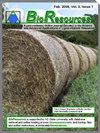Proanthocyanidin-rich extract from Pinus radiata bark: Mild-alkaline extraction and characterization
IF 1.6
4区 农林科学
Q2 MATERIALS SCIENCE, PAPER & WOOD
引用次数: 0
Abstract
This study assessed the efficacy of mild-alkaline extraction from P. radiata bark in obtaining proanthocyanidin (PA)-rich extracts. When the bark was treated with three types of bases—Na2CO3, NaHCO3, and NaOH—at varying concentrations, the extract yields increased with higher concentrations. When the pH of the extracts exceeded 7, the PA content and antioxidant activity were remarkably reduced. This result suggests that the pH holds a greater effect in the alkaline extraction of the bark rather than the type of base used. Among the bases used, NaHCO3 was selected and the extraction conditions of pine bark were examined at a concentration where the pH of the extract did not exceed 7. The extraction time during mild-alkaline extraction using 0.2% NaHCO3 was reduced compared to water-only extraction at the same temperature. Moreover, the extract yields were over 10% higher than those of water extraction, and the dried extracts exhibited good solubility in water. The mild-alkaline extracts were characterized using FT-IR and 13C NMR spectroscopic techniques, and acidic alcoholysis. Analyses of the spectra of the mild-alkaline extracts showed similarities to that of pure PA and hot water extract. This result indicated that PA in the bark was not significantly affected during mild-alkaline extraction.从松树树皮中提取富含原花青素的提取物:弱碱性提取和特征描述
本研究评估了从鼠李树皮中进行弱碱性萃取以获得富含原花青素(PA)的提取物的效果。用三种不同浓度的碱--Na2CO3、NaHCO3 和 NaOH--处理树皮时,提取物的产量随着浓度的升高而增加。当提取物的 pH 值超过 7 时,PA 的含量和抗氧化活性明显降低。这一结果表明,在树皮的碱性提取过程中,pH 值的影响比所用碱的类型更大。在所使用的碱中,选择了 NaHCO3,并在提取物 pH 值不超过 7 的浓度下考察了松树皮的提取条件。此外,提取物的产量比水提取高出 10%以上,干燥后的提取物在水中具有良好的溶解性。利用 FT-IR 和 13C NMR 光谱技术以及酸性醇解对弱碱性提取物进行了表征。对弱碱性提取物光谱的分析表明,它们与纯 PA 和热水提取物的光谱相似。这一结果表明,树皮中的 PA 在弱碱性提取过程中没有受到明显影响。
本文章由计算机程序翻译,如有差异,请以英文原文为准。
求助全文
约1分钟内获得全文
求助全文
来源期刊

Bioresources
工程技术-材料科学:纸与木材
CiteScore
2.90
自引率
13.30%
发文量
397
审稿时长
2.3 months
期刊介绍:
The purpose of BioResources is to promote scientific discourse and to foster scientific developments related to sustainable manufacture involving lignocellulosic or woody biomass resources, including wood and agricultural residues. BioResources will focus on advances in science and technology. Emphasis will be placed on bioproducts, bioenergy, papermaking technology, wood products, new manufacturing materials, composite structures, and chemicals derived from lignocellulosic biomass.
 求助内容:
求助内容: 应助结果提醒方式:
应助结果提醒方式:


